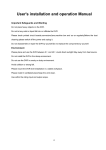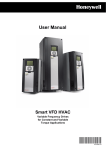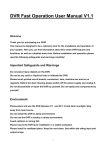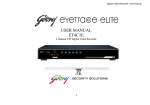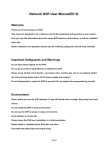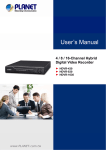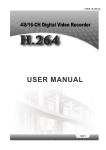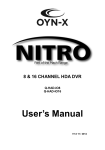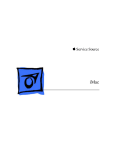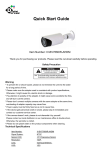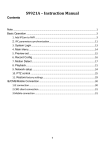Download USER MANUAL USER MANUAL
Transcript
USER MANUAL ET - 4AHD1 AHD Digital Video Recorder USER MANUAL ET – 4AHD1, ET – 8AHD1 And ET - 16AHD2 AHD Digital Video Recorder AHD DVR User Manual Welcome Thank you for purchasing our AHD DVR! This manual is designed to be a reference tool for the installation and operation of your system. Here you can find information about this series AHD DVR features and functions, as well as a detailed menu tree. Before installation and operation please read the following safeguards and warnings carefully! Important Safeguards and Warnings Do not place heavy objects on the AHD DVR. Do not let any solid or liquid fall into or infiltrate the AHD DVR. Please brush printed circuit boards, connectors, fans, machine box and so on regularly. Before the dust cleaning please switch off the power supply and unplug it. Do not disassemble or repair the AHD DVR by yourself. Do not replace the components by yourself. Environment Please place and use the AHD DVR between 0℃ and 40℃.Avoid direct sunlight. Stay away from heat source. Do not install the AHD DVR in damp environment. Do not use the AHD DVR in smoky or dusty environment. Avoid collision or strong fall. Please insure the AHD DVR level installation in a stable workplace. Please install in ventilated place. Keep the vent clean. Use within the rating input and output scope. This manual supports ET – 4AHD1, ET – 8AHD1, and ET -16AHD2 AHD DVR Contents 1 Product Introduction .............................................................................................................1 1.1 Product Overview .......................................................................................................1 1.2 Main Functions...........................................................................................................1 2 Open-package Check and Cable Connections............................................................................... ..3 2.1 Open-package Check ..................................................................................................3 2.2 Hard Disk Installation .................................................................................................. .4 3 Basic Operation.....................................................................................................................5 3.1 Turn On.................................................................................................................. ..5 3.2 Turn Off................................................................................................................. ..5 3.3 System Login ........................................................................................................... ..6 3.4 Preview................................................................................................................... 6 3.5 Desktop Shortcut Menu ............................................................................................ .....7 3.5.1 Main Menu ..................................................................................................... .8 3.5.2 Playback........................................................................................................ .8 3.5.3 Record Mode................................................................................................... 12 3.5.4 Alarm Output .................................................................................................. 13 3.5.5 PTZ Control..................................................................................................... 13 3.5.6 Color Setting.................................................................................................... 18 3.5.7 Output Adjust.................................................................................................. 19 3.5.8 Logout........................................................................................................... 20 3.5.9 Window Switch................................................................................................. 20 4 Main Menu ..........................................................................................................................21 4.1 Main Menu Navigation ................................................................................................ ...21 4.2 Record.................................................................................................................. ...23 4.2.1 Record Config................................................................................................... 23 4.2.2 Playback......... ............................................................................................... 24 4.2.3 Backup........................................................................................................... 24 4.3 Alarm Function........................................................................................................ ...26 4.3.1 Motion Detect...................................................................................................26 4.3.2 Video Blind......................................................................................................29 4.3.3 Video Loss .......................................................................................................30 4.3.4 Alarm Input ..................................................................................................... 31 4.3.5 Abnormal ....................................................................................................... 31 4.4 System Setup ........................................................................................................ .....32 4.4.1 General......................................................................................................... .32 4.4.2 Encode Setup ................................................................................................. .34 4.4.3 Network Setup ............................................................................................... ..35 4.4.4 Net Service ................................................................................................... ..36 4.4.5 GUI Display................................................................................................... ..42 4.4.6 PTZ Setup .................................................................................................... ..43 4.4.7 RS232 Setup ................................................................................................. ..44 4.4.8 Tour Setup ................................................................................................... ..44 4.5 Advanced ........................................................................................................... .....45 4.5.1 HDD manage ................................................................................................. .45 4.5.2 Account ....................................................................................................... .46 4.5.3 Online User .................................................................................................. ..49 4.5.4 Auto Maintain ............................................................................................... ..49 4.5.5 Restore ....................................................................................................... ..50 4.5.6 Upgrade...................................................................................................... ..50 4.5.7 Digital..... ............................................................................................... ......51 4.6 Info................................................................................................................. ......55 4.6.1 Device Info....................................................................................................55 4.6.2 HDD Info.......................................................................................................56 4.6.3 BPS ..................................................................................... .......................56 4.6.4 LOG........................................................................................................... .57 4.6.5 Version ...................................................................................................... ..57 5 FAQ and Maintenance .................................................................................................... ......58 5.1 FAQ .................................................................................................................. ...58 5.2 Maintenance........................................................................................................ ...62 II 1 Product Introduction 1.1 Product Overview The series AHD DVR is designed especially for security and defense field which is an outstanding digital surveillance product. It introduces embedded LINUX operating system which is more stable. It introduces standard H.264 video compressed format and G.711A audio compressed format which insures the high quality image, low error coding ratio and single frame playing. It introduces TCP/IP network technology which achieves the strong network communication ability and telecommunication ability. The series AHD DVR can be used individually or online applied as a part of a safety surveillance network. With the professional network video surveillance software it achieves the strong network communication ability and telecommunication ability. The series AHD DVR can be applied in the bank, telecom, electric power system, judicial system, transportation, intelligent housing, factory, storehouse, water conservancy and so on. 1.2 Main Functions Real-time Surveillance „ Analog interface and VGA interface (VGA interface is equipped selectively). „ Surveillance function through monitor or display. Storage „ Non-working hard disk dormancy processing which is convenient to radiate heat, reduce power and extend the life-span. „ Special storage format which insures the data safety. Compression „ Real-time compression by individual hard disk which insures the audio and video signal stable synchronization. 1 Backup „ Through SATA interface and USB interface such as USB equipment, removable hard disks and so on through net download the files in the hard disk. Playback „ Individual real-time video recording as well as searching, playback, network surveillance, recording check, downloading and so on. „ Multi-playback mode. „ Zoom at arbitrary region. Communication Interface „ RS485 interface which fulfills the alarm input and PTZ control. „ Standard Ethernet network interface which fulfills the telecommuting function. Intelligent Operating „ Mouse action function. „ Fast copy and paste operating for the same setting. 2 2 Open-package Check and Cable Connections 2.1 Open-package Check When you receive the AHD DVR, please check first .First; please check whether there is any visible damage to the package appearance. The protective materials used for the package of the AHD DVR can protect most accidental clashes during transportation. Then, please open the box and get rid of the plastic protective materials. Check whether there is any visible damage to the AHD DVR appearance. At last, please open the machine crust and check the data wire in the front panel, power wire, the connection between the fan power and the main board. Front Panel and Rear Panel „ The key function specification in the front panel and the interface specification in the real panel are in the specification. „ Please check the product type in the front panel whether is accordant with the product type you order. Note: The label in the real panel is very important for the after service Pleas protect it carefully When you contact us for after service please provided the product type and serial number in the label 3 2.2 Hard Disk Installation Before you use the DVR for the first time, the HDD should be installed in, 1/2/4 units of HDD can be installed according to the model of DVR. For the first use please install the hard disk. 1 disassemble the screw ○ ②disassemble the cover ③fix the screw of hard disk ④fix the screw of hard disk ⑤connect the data wire ⑥connect the power wire Name Video input Video output VGA Audio output Audio input port “485” (AB) External alarm port USB Description Standard BNC port connected with the Camera. Connected with the video input of the monitor. VGA video signal output port connected with a VGA port of a computer monitor. Connected with earphone or cable speaker. Connected to audio input device. RS485, it can connect PTZ or decoder, and can Control PTZ via the panel, mouse, remote control and network. Connected with alarm input and output. Connected to USB Pen-drive or mouse and used for system software upgrade or video file backup. NET RJ-45 network port connected to network cable and used for remote browse or control. Power Power input is DC 12V/5A (16 Channel DVR). Power input is 12V/3A (4/8 channel DVR). 4 3 Basic Operation Note : The button in gray display indicates non-support. 3.1 Turn On Plug the power supply and turn on the power supply switch. Power supply indicator light shining indicates turning on the video recorder. After the startup you will hear a beep. The default setting of video output is multiple-window output mode. If the startup time is within the video setting time, the timing video recording function will start up automatically. Then the video indicator light of corresponding channel is shining and the AHD DVR is working normally. 1. Make sure that the input voltage corresponds with the switch of the AHD DVR power supply. 2. Power supply demands: 220V±10% /50Hz. Suggest using the UPS to protect the power supply under allowable conditions. 3.2 Turn Off There are two methods to turn off the AHD DVR. Entering <Main Menu> and choosing <Turn Off> in the <Turn off the system> option is called soft switch. Pressing the power supply switch is called hard switch. Illumination: (1) Auto resume after power failure. If the AHD DVR is shut down abnormally, it can automatically backup video and resume previous working status after power failure. (2) Replace the hard disk Before replacing the hard disk, the power supply switch in the real panel must be turned off. (3) Replace the battery . Before replacing the battery, the setting information must be saved and the power supply switch in the real panel must be turned off. The AHD DVR uses button battery. The system time must be checked regularly. If the time is not correct you must replace the battery, we recommend replacing the battery every year and using the same battery type. 5 Note : The setting information must be saved before replacing the battery otherwise information will lose. 3.3 System Login When the AHD DVR boots up, the user must login and the system provides the corresponding functions with the user purview. There are three user settings. The names are admin, guest and default and these names have no password. Admin is the super user purview; guest and default’s permissions are preview and video playback. User admin and guest’s password can be revised, while their permissions can’t be revised; user default is the default login user whose permission can be revised but not its password. User Name: admin Password: No password Click OK to enter the system. Figure 3.1 System Login Note: Password protection: If the password is continuous wrong three times, the alarm will start. If the password is continuous wrong five times, the account will be locked. (Through reboot or after half an hour, the account will be unlocked automatically) For your system security, please modify your password after first login. 3.4 Preview You can right click mouse to choose the switch between the windows. The system date, time and channel name are shown in each viewing window. The surveillance video and the alarm status are shown in each window. Table 3.1 Preview icon 1 Recording status 2 Motion detect 6 3 Video loss 4 Camera lock 3.5 Desktop Shortcut Menu In preview mode you can right click mouse to get a desktop shortcut menu. The menu includes: Main Menu, Record Mode, PlayBack, PTZ Control, High Speed PTZ, Alarm Output, Color Setting, Output Adjust, Logout, View1/4/8/9/16 screens. Figure 3.2 Shortcut Menu 7 3.5.1 Main Menu When you login,and click on Main menu, the system main menu is shown as below. Figure 3.3 Main Menu 3.5.2 Playback There are two methods for you to play the video files in the hard disk. (1) In the desktop shortcut menu. (2) <Main menu> Æ <Record> Æ <Playback> Note: The hard disk that saves the video files must be set as read-write or read-only state. (4.5.1) 8 Figure 3.4 video playback 1. Listed files 4. File backup 2. File information. 5. Operation hint 3. File searching 6. Playback control <Listed files> Look up the listed files that accord with the searching criteria. <File information> Look up the found file information. <File backup> Backup the chosen file. Click the button and operate as followed. The storage must be installed before the file backup. If the backup is terminated, the already backup can playback individually. 9 Figure 3.5 detect the storage <Detect> Detect the storage connected with the AHD DVR such as hard disk or universal disk. <Erasure> Choose the file to delete and click erasure to delete the file. <Stop> Stop the backup. <Backup> Click backup button and the dialog box is popped up. You can choose the backup file according to the type, channel and time. Figure 3.6 recording backup 10 <Remove> Clear the file information. <Add> Show the file information satisfying the set file attributes. <Start/Pause> Click the play button to start the backup and click the pause button to stop the backup. <Cancel> During backup you can exit the page layout to carry out other functions. <File searching> Search the file according to the searching parameter. Figure 3.7 file searching <File type> Set the searching file type. <Channel> Set the searching channel. <Start Time> Set the searching time scan. <Playback Control> Refer to the following sheet for more information. Table 3.2 Playback control key Button / Function Button Function Play/pause Backward Stop Slow play Fast play frame Previous Next frame Previous file 11 Next file Circulation Full screen Frame by frame playback is only performed in the pause playback state. <Operation hint> Display the function of the cursor place. Special functions: <Accurate playback> Input time (h/m/s) in the time column and then click play button. The system can operate accurate playback according to the searching time. <Local zoom> When the system is in single-window full-screen playback mode, you can drag your mouse in the screen to select a section and then left click mouse to realize local zoom. You can right click mouse to exit. 3.5.3 Record Mode Please check current channel status: “○” means it is not in recording status, “●” means it is in recording status. You can use desktop shortcut menu or click <Main menu> Æ <recording function> Æ <recording set> to enter the recording control interface. Figure 3.8 Record Mode <Schedule> Record according to the configuration. <Manual> Click the all button and the according channel is recording no matter the channel in any state. <Stop> Click the stop button and the according channel stops recording no matter the channel in any state. 12 3.5.4 Alarm Output The Alarm output function is only possible in ET – 16AHD2. You can use desktop shortcut menu or click <Main Menu> Æ <Alarm Function> Æ <Alarm Output> to enter the alarm output interface. <Configuration> Alarm is on according to the configuration. <Manual> Click the all button and the according channel is alarming no matter the channel in any state. <Stop> Click the stop button and the according channel stops alarming no matter the channel in any state. 3.5.5 PTZ Control Operation interface is as followed. The functions include: PTZ direction control, step, zoom, focus, iris, and setup operation, patrol between spots, trail patrol, boundary scan, assistant switch, light switch, level rotation and so on. „ Decoder A (B) line connects with AHD DVR A (B) line. The connection is right. „ Click <Main menu> Æ<System configuration> Æ<PTZ setup> to set the PTZ parameters. „ The PTZ functions are decided by the PTZ protocols. Figure 3.9 PTZ Setup <Speed> Set the PTZ rotation range. Default range: 1 ~ 8. <Zoom> Click / button to adjust the zoom multiple of the camera. <Focus> Click / button to adjust the focus of the camera. <Iris> Click / button to adjust the iris of the camera. 13 <Direction Control> Control the PTZ rotation. 8 directions control is supportive.(4 directions in Front panel is supportive). <High Speed PTZ> Full-screen show channel image. Left press mouse and control PTZ to rotate orientation. Left press mouse and then rotate the mouse to adjust the zoom multiple of the camera. <Set> Enter the function operation menu. <Page Switch> Switch between different pages. Special functions: 1. Preset Set a location for the preset, calls the preset points, PTZ automatically turns to the setting position . 1) Preset option Set a location for the preset, procedure is as follows: Step1: in Figure 3.9, click the Direction button will turn into preset position, click the Settings button to enter Figure 3.10. Step 2: click the Preset button, and then write the preset points in the input blank, Step 3: click Settings button, return the Figure 3.9 Complete setup, that is the preset points and preset position corresponds. Clear Preset: Input preset points, click Remove button, remove the preset. Figure 3.10 Preset Setting 2) Preset Point Calls In Figure 3.9, click Page Shift button, enter PTZ control interface as shown in Figure 3.11. In the input blank, write the preset points, then click Preset button, PTZ turn to the 14 corresponding preset point. Preset button Preset point input blank. Figure 3.11 PTZ Control 2. Cruise between Points Multiple preset points connected cruise lines, call cruise between points, the PTZ run around on the line. 1) Cruise Between Points Settings Cruise lines are connected by multiple preset points, setting procedure is as follows: Step1: In Figure 3.9, the Direction key will turn PTZ to designated location, click Settings button to enter Figure 3.12. Step 2: Click Cruise buttons, the write proper value into the Cruise Line and Preset Points blank,then click Add Preset Points button, complete setting (also can add and delete cruise line which has been set up). Step 3: Repeat step1 and step2, until set out all the preset designated cruise lines. Remove Preset: Please input preset value in the blank, click Remove Preset button, then remove the preset points. Remove Cruise Line: Input the number of cruise line, click Remove Cruise Lines button, then remove the cruise lines set. 15 Figure 3.12 Cruise Between Points Setting 2) The Calls of Cruise between Points In Figure 3.9, click Page Shift button, enter PTZ control menu as shown in Figure 3.11. Please input the number of cruise in the value blank, then click Cruise between Points button, PTZ begins to work on the cruise line. Click Stop button to stop cruise. 3. Scan PTZ also can work on the preset scan line repeatedly. 1) Scan setup Step1: In Figure 3.9, click Setup button enters Figure 3.13; Step2: Click Scan button,the input proper value in the scan value blank; Step3: Click Start button, enter Figure3.9,here you can set the following items: Zoom/Focus/Aperture/Direction and so on. Click Setup button to go back Figure 3.13; Step4: Click End button to complete setup. Click the right button of the mouse to exit. Figure 3.13 Scan Setup 2) Scan Calls In Figure 3.9, click Page Shift button, then enter PTZ control menu as shown in Figure 3.11. Please input the number of scan in the16value blank, and then click Scan button,PTZ begins to work on the scan line. Click Stop button to stop. 4. Boundary Scan 1) Boundary Scan setup Step1: In Figure 3.9, click Direction button to turn the PTZ to preset direction, then click Setup button enter Figure 3.14, select the left boundary, return to Figure 3.9; Step2: Please click direction arrows to adjust PTZ direction, click Setup button enter Figure3.14, and then select the right boundary, return to Figure 3.9; Step3: Complete setup, that is the position of left and right boundary Figure 3.14 Boundary Scan Setup 2) Boundary Scan Calls In Figure 3.9, click Page Shift button, then enter PTZ control menu as shown in Figure 3.11. Please input the number of scan in the value blank , then click Scan button,PTZ begins to work on the scan line . Click Stop button to stop. 3) Horizontal Rotating Click Horizontally Rotating button, PTZ begins to rotate horizontally (relative to the original position of the camera) Click the Stop button to stop. 4) Rotate Click on horizontal Rotating button, PTZ turn around. 17 5) Reset Line scan button border. PTZ restart, all the data clears to 0. 6) Page Shift In Figure 3.11, click Page Shift button into Figure3.15, setting auxiliary function. Auxiliary number corresponding to auxiliary switch on the decoder. Figure 3.15 Auxiliary Function Control <Intuitive Auxiliary Operation> Choose auxiliary equipment, select Open or Close button, switch control. <Auxiliary Number> The operation of corresponding auxiliary switch according to PTZ agreement. <Page Shift> In Figure 3.15,click Page Shift button enter the Figure 3.9 PTZ Main Menu , the menu itself can be control by the menu control buttons. 3.5.6 Color Setting Set the selective image parameters (current channel for single window display and cursor place for multi-window display) You can use the desktop shortcut menu and enter the interface. The image parameters include: tonality, brightness, contrast, saturation. You can set different parameters at different time sections. 18 Figure 3.16 Color Setting 3.5.7 Output Adjust Adjust TV output area parameters. You can use the desktop shortcut menu or enter <Main Menu> Æ <Management Tools> Æ <Output Adjust>. Figure 3.17 Output Adjust 19 3.5.8 Logout Logout shut down the system or reboot up. You can use the desktop shortcut menu or enter <Main menu>. Figure 3.18 Logout/Shutdown/Reboot the system <Logout> Quit the menu. Offer password next entrance. <Shut down> Quit the system. Turn off the power supply. When press the shutdown button, there is schedule hint. After three seconds, the system is shut down. Cancel midway is of no effect. <Reboot> Quit the system. Reboot up the system. 3.5.9 Window Switch Preview in single window/four windows/eight windows/nine windows/sixteen windows according to your choice. 20 4 Main Menu 4.1 Main Menu Navigation Main Menu Sub Menu Config Record Playback backup Motion detection Video blind Alarm Video loss Alarm input Alarm output System General configuration configuration Encode configuration Network configuration Net Service Functio n Set the recording configuration, recording type, recording time section Set recording look-up, recording play, video file storage Detect or format backup equipment, back the selective files Set motion detect alarm channel, sensitivity, area, linkage parameters: defending time section, alarm output, screen hint, recording, Set cameraPTZ, maskpatrol alarm channel, sensitivity, linkage parameters: defending time section, alarm output, screen hint, recording, PTZ, patrol Set video loss alarm channel, linkage parameters: defending time, section, alarm output, screen hint, recording, PTZ, patrol Set alarm input channel, equipment type, linkage parameters: defending time section, alarm output, screen hint, recording, PTZ,alarm patrolmode: configuration, manual, Set shut down Set system time, data format, language, hard disk full time operation, machine number, video format, output mode, summertime, stay time Set main(assistant)coding parameter: code mode, resolving ability, frame rate, code stream control, image quality type, code stream value, frame between value, video/audio enable Set basic network parameters, DHCP and DNS parameters, network high speed download PPPOE,NTP,EMAIL PREVIEW,DDNS PARAMETER,FTP,MOBILE MONITOR,WIRELESS CONFIG,WIFI,CLOUD 21 Set channel name, preview hint icon state, GUI display transparency, cover area, time title, channel PTZ timechannel, fold Set PTZ protocol, address, baud rate, configuration date bit, stop bit, check Serial port Set serial port function, baud rate, date bit, Configuration stop bit, check (RS232) Tour Set patrol mode and interval time Set appointed hard disk as read-write Hard disk disc, read-only management disc or redundant disc, clear data, resume date and so on User Modify user, team or password. Add user or management team. Delete user or team. Break the connection with the already Online user login user. Lock the account after, break until booting up again. Management tools Adjust TV upside, downside, nearside, TV adjust starboard distance Automatic Set automatic reboot system and maintenance automatic deleting files. Resume setup state: common setup, code setup, Restore recording setup, alarm setup, network setup, network service, preview playback, serial port, setup, user management Hard disk Display hard disk capability and recording time informatio n Code stream Display code stream information System statistics informatio Log Clear all log information according to the n informatio log video and time n Edition Display edition information informatio Shut down n Logout, shut down or reboot 22 4.2 Record 4.2.1 Record Config Set the recording parameters in the surveillance channel. The system is set 24 hours consecutive recording in the first startup. You can enter <Main Menu> Æ <Recording function>Æ<Recording setup> to set. Note: There is at least one read-write hard disk.(refer to chapter 4.5.1) Figure 4.1 Record Config There is no Alarm configuration in ET-4AHD1and ET-8AHD1 <Channel> Choose the corresponding channel number to set the channel. Choose the all option to set the entire channels. <Redundancy> Choose the redundancy function option to implement the file double backup function. Double backup is writing the video files in two hard disks. When you do the double backup, make sure that there are two hard disks installed. One is read-write disk and the other is redundant disk. (refer to 4.5.1). <Length> Set the time length of each video file. 60minutes is default value. 23 <PreRecord> Record 3 seconds before the action. (Time length is decided by the code stream). <Record mode> Set video state: schedule, manual or stop. Schedule: Record according to the set video type (Common, detection and alarm) and time section. Manual: Click the button and the according channel is recording no matter the channel in any state. Stop: Click the stop button and the according channel stops recording no matter the channel in any state. <Period> Set the time section of common recording. The recording will start only in the set range. <Record type> Set recording type: regular, detection or alarm. Regular: Perform the regular recording in the set time section. The video file type is “R”. Detect: Trigger the “motion detect”, “camera mask” or “video loss” signal. When above alarm is set as opening recording, the“detection recording” state is on. The video file type is “M”. Alarm: Trigger the external alarm signal in the set time section. When above alarm is set as opening recording, the “detection recording” state is on. The video file type is “A”.Alarm type recording happens only in ET – 16AHD2 Refer to chapter 4.3 to set corresponding alarm function. 4.2.2 Playback Refer to chapter 3.5.2. 4.2.3 Backup You can back up the video files to external storage through setup. Note: The storage must be installed before the file backup. If the backup is terminated, the already backup can playback individually. 24 Figure 4.2 Backup <Detect> Detect the storage connected with the AHD DVR such as hard disk or universal disk. <Erase> Choose the file to delete and click erasure to delete the file. <Stop> Stop the backup. <Backup> Click backup button and the dialog box is popped up. You can choose the backup file according to the type, channel and time. 25 Figure 4.3 File Backup <Remove> Clear the file information. <Add> Show the file information satisfying the set file attributes. <Start/pause> Click the play button to start the backup and click the pause button to stop the backup. <Cancel> During backup you can exit the page layout to carry out other functions. 4.3 Alarm Function Alarm functions include: motion detect, video blind, video loss, alarm input and alarm output. 4.3.1 Motion Detect When system detects the motion signal that reaches the set sensitivity, the motion detect alarm is on and the linkage function is turned on. 26 Figure 4.4 Motion Detect <Channel> Choose the set motion detect channel. <Enable> Means that the motion detects function is on. <Sensitivity> Choose in the six options according to the sensitivity. <Region > Click setup and enter the set area. The area is divided into PAL22X18. Green block means the current cursor area. Yellow block means the dynamic detect defensive area. Black block means the unfenced area. You can set the area as followed, Drag the mouse and draw the area. Figure 4.5 Region 27 <Period> Trigger the motion detect signal in the set time section. You can set according to week or set uniformly. Each day is divided into four time sections. ‘■’ means the set valid. Figure 4.6 set the time section <Interval> Only one alarm signal is turned on even there are several motions detect signals in the set interval. <Alarm output> Start the external equipment of corresponding linkage alarm when the motion detection alarm is turned on. <Delay> Delay a few moments and stop when the alarm state is turned off. The range is 10~300 seconds. <Record channel> Choose the recording channel (multiple options supportive)Trigger the video signal when the alarm is turned on. Note: Set in the <recording setup> and perform the linkage recording. Start detecting video files in the corresponding time section. <Tour> Meaning that the selective channel is single window alternate patrol preview. The interval is set in the <Main Menu> Æ <System> Æ <Tour>. 28 <PTZ Activation>Set the PTZ activation when the alarm is turned on. Note: PTZ activation is set in the <Shortcut menu> Æ <PTZ control>. Set the patrol between spots, trail patrol and so on. Figure 4.7 PTZ Activation <Delay> When alarm is over, recording will last some seconds (10~300sec), then stop. <Show message> Pop the alarm information dialog box in the local host computer screen. <Send EMAIL> Means to send an email to user when the alarm is turned on. Note: Set in the <Net Service> and send email. 4.3.2 Video Blind When the video image is influenced by the environment such as bad brightness or reaching the set sensitivity parameter, the camera mask function is turned on and the linkage function is turned on. 29 Figure 4.8 Video Blind Set method: refer to chapter 4.3.1. Motion detect Note: “Advanced” button is the same as right click. 4.3.3 Video Loss When the equipment cannot obtain the channel video signal, the video loss alarm is turned on and the linkage function is turned on. Figure 4.10 Video loss Figure 4.9 Video Loss 30 Set method: refer to chapter 4.3.1. Motion detect Note: “Advanced” button is the same as right click. 4.3.4 Alarm Input When the equipment obtains the external alarm signal, the alarm function is turned on.This function supports only in ET – 16AHD2. Figure 4.10 Alarm Input Set method: refer to chapter 4.3.1. Motion detect Note : "Advanced" button is the same as right click. 4.3.5 Abnormal Analyzing and inspecting current software and hardware of the device: When some abnormal events happen, the device will make a relative answer such as show message and buzzer. 31 Figure 4.11 Abnormal <Event Type> selecting abnormity you want to inspect. <Enable> Select it to make sure abnormal function workable. <Show message> Automatically alarm cue dialog box come out of the main screen. <Buzzer> Device will have two long voice “beep” while alarm is happening. 4.4 System Setup Set the system parameters such as General, Encode, Net Work, Net Service, GUI Display, PTZ Config, RS232 and Tour Setup. 4.4.1 General Figure 4.12 General Setup 32 <System time> Set the system data and time. <Date format> Choose the data format: YMD, MDY, and DMY. <Date Separator> Choose list separator of the data format. <Time Format> Choose time format: 24-hour or 12-hour. <Language>English, S-Chinese, T-Chinese, Italian,Spanish,French,Dutch, Portuguese,Turkish,Poland,Hungarian <HDD full> Choose stop record: Stop recording when the hard disk is full. Choose overwrite: Cover the earliest recording files and continue recording when the hard disk is full. <DVR No. > Only when the address button in the remote controller and the corresponding DVR number is matched, the remote operation is valid. <Video Standard> PAL or NTSC. <Auto Logout> Set the latency time in 0-60. 0 means no latency time. <DST> Choose the summer time option and pop the dialog box as followed. Figure 4.13 DST (Week) Figure 4.14 DST (Date) 33 4.4.2 Encode Setup Set the video/audio code parameter: video file, remote monitoring and so on. Set every independent channel’s coding parameter in the left part, and set the combine encode parameter in the right part. Note : Combine encode introduces video compression technique which combines and compresses multi-channel’s video to a special channel. Applying for Multi-channel playback simultaneously, Dial-up multi-channel real-time monitor, mobile monitor and so on. Figure 4.15 Encode setup <Channel> Choose the channel number. <Compression> Standard H.264 main profile. <Resolution> Resolution type: AHDM (720p), AHDL (960H),D1,CIF,QCIF. <Frame Rate> P: 1 frame/s~25 frame/s; N: 1 frame/s~30 frame/s. <Bit Rate Type> You can choose limited code stream or variable code stream. When you choose the variable code stream there are six image quality options. <Bit Rate> Set the code stream value to modify the image quality. The larger code stream value the better image quality. 34 <Video/Audio> When the icons are all in reverse displayed, the video file is video and audio multiplex stream. Combine Enable. <Combine Enable> When the icons are all in reverse displayed, opening combination coding functions. <Mode> Multi-channel playback is used in all channels playback simultaneously, and the narrowband transmission is used in multi-channel real-time remote monitoring simultaneously at narrowband state, especially used in mobile monitor. 4.4.3 Network Setup Figure 4.16 Network <Net Card> You can choose cable network card or wireless network card. <DHCP Enable> Obtain IP address automatically (not suggested) DHCP server is preinstalled. <IP address> Set the IP address. Default: 192.168.1.10. <Subnet mask> Set the subnet mask code. Default: 255.255.255.0. <Gateway> Set the default gateway. Default: 192.168.1.1. <DNS setup> Domain Name Server. It translates the domain name into IP address. The IP address is offered by network provider. The 35 address must be set and reboot then it works. <TCP port> Default: 34567. <HTTP port> Default: 80. <HS Download> High Speed Download. <Transfer Policy> There are three strategies: self-adaption, image quality precedence and fluency precedence. The code stream will adjust according to the setup. Self-adaption is the tradeoff between the image quality precedence and fluency precedence. Fluency precedence and self-adaption are valid only when the assistant code stream is turned on. Otherwise image quality precedence is valid. 4.4.4 Net Service Choose the network service option and click the set button to configure the advanced network functions or double click the service button to configure the parameters. Figure 4.17 Net Service 36 <PPPoE Setup> Input the user name and password that ISP(Internet service provider) provides. After saving it reboot up your system. Then the AHD DVR will build a network connection based on PPPoE. The IP address will change into dynamic IP address after above operation is well done. Figure 4.18 PPPoE Operation: After PPPoE dialing successfully look up the IP address in the <IP address> and obtain the current IP address. Then use this IP address to visit the AHD DVR through user port. <NTP setup> The NTP server must be installed in the PC. Figure 4.19 NTP <Host computer IP> Input the IP address installed NTP server. <Port> Default 123. You can set the port according to NTP server. <Time zone> London GMT+0 Berlin GMT +1 Cairo GMT +2 Moscow GMT +3 New Delhi GMT+5 Bangkok GMT +7 Hong Kong Beijing GMT +8 Tokyo GMT +9 Sydney GMT +10 Hawaii GMT-10 Alaska GMT-9 Pacific time GMT-8 American mountain time GMT-7 American mid time GMT-6 American eastern time GMT-5 Atlantic time GMT-4 Brazil GMT-3 Atlantic mid time GMT-2. 37 <Update Period> The same with the NTP server check interval. Default: 10minutes. <EMAIL setup> If the alarm is turned on or the alarm linkage photos are taken. Send an email about the alarm information and the photos to appoint address. Figure 4.20 EMAIL <SMTP Server> Email server address. It could be an IP address or domain name. Domain name can be translated only it is the correct DNS configuration. <Port> Email server port number. <SSL> Decide whether using Secure Socket Layer protocol to login. <User Name> Apply the email server user name. <Password> Input the password corresponding to the user. <Sender> Set the email sender address. <Receiver> Send the email to appointed receivers when the alarm is turned on. You can set three receivers at most. <Title> You can set as you wish. <IP Filter setup> Note: When choosing the white list, only the listed IP address can connect the AHD DVR. The 64 IP addressed are supportive in the list. When choosing the black list, the listed IP address cannot connect the AHD DVR. The 64 IP addressed are supportive in the list. You can delete the set IP address by √ in the options. When the same IP address is in the white and black list at the same time, the black list precedence is higher. 38 Figure 4.21 IP FILTER <DDNS> It is the abbreviation of dynamic domain name server. <Local domain name> Provide the domain name registered by DDNS. <User name> Provide the account registered by DDNS. <Password> Provide the password registered by DDNS. When the DDNS is successfully configured and start, you can connect the domain name in the IE address column to visit. Note: The DNS setup must be configured correctly in the network setup. Figure 4.22 DDNS setup <FTP Setup> FTP is available only when alarm happens, or alarm activates record and snapshot, it will upload related record and napshot pictures to FTP server. 39 Figure 4.23 FTP setup <Enable> Click Enable, then all settings will be available. <Server IP> IP address for FTP server. <Port> Domain Port of FTP, default 21. <User Name> User name of FTP. <Password> Password of user. <Max File Length> Max length for upload files at every packed, default 128M. <Dir. Name> Directory of uploading files. <Wireless Config> ADSL through 3G net card, use CMS to visit and config the device. Figure 4.24 Wireless Config <Enable> Choose Enable to make all settings available. <Type> Dial type, default AUTO. 40 <Wireless AP> 3G access point. <Dial Number> 3G Dial Number. <User Name> User name of 3G. <Password>Password of dial user. <IP Address> IP address, got from dial. <Mobile Monitor Setup> To visit the device by mobile, plus make a router mapping of this port and use CMS to monitor and operate it by protocol. Figure 4.25 Mobile Monitor Setup <Enable> Select it to make sure abnormal function workable. <Port> It’s a port of mobile monitoring which you need to make a router mapping of if want to visit it by mobile. <UPNP> UPNP protocol can auto port forwarding on router, make sure UPNP is running on router before use it. Figure 4.26 UPNP <Enable> Choose Enable to make sure all UPNP settings available. 41 <HTTP> Route will automatically distribute HTTP port for the device, when IE viewing, it needs this port (e.g. 60.12.9.26:66) <TCP> Router will automatically distribute TCP port for the device, when monitoring via CMS, it need this port. <Mobile Port> Router will automatically distribute Mobile Port for the device, when mobile monitor, it need this port. 4.4.5 GUI Display Configure the video output parameters including the front output mode and code output mode. Front output: In the local preview mode include: channel title, time display, channel title, record status, alarm status, bit rate info, transparency and region cover. Code output: In the network surveillance and video file mode include: channel title, time display, channel title, record status, alarm status, bit rate info, transparency and region cover. Figure 4.27 GUI Display <Channel Title> Click the channel name modify button and enter the channel name menu. Modify the channel name. The 16 Chinese characters and 25 letters are supportive. 42 <Time Display> Means the selective state. Display the system data and time in the surveillance window. <Channel Title> Means the selective state. Display the system channel number in the surveillance window. <Record Status> Means the selective state. Display the system recording status in the surveillance window. <Alarm Status> Means the selective state. Display the system alarm status in the surveillance window. <Bitrate info> Means the selective state. The ninth window displays the code stream information in the nine-window preview status. <Transparency> Choose the background image transparency. The range is128~255. <Resolution> Set display resolution. <Channel> Choose the set code output channel number. <Region Cover> Means the selective state. Click the cover area button and enter the corresponding channel window. You can cover the arbitrary using mouse. (Black region is for output) 4.4.6 PTZ Setup Figure 4.28 PTZ setup <Channel> Choose the dome camera input channel. <Protocol> Choose the corresponding dome protocol. (PELCOD as an example) <Address > Set as the corresponding dome address. Default: 1. The address must be consistent with the dome address. 43 <Baud rate> Choose the corresponding dome baud rate length. You can control the PTZ. Default: 115200. <Data bits> Include 5-8 options. Default: 8. <Stop bits> Include 2 options. Default: 1. <Parity> Include odd check, even check, sign check, blank check. Default: void. 4.4.7 RS232 Setup Figure 4.29 RS232 setup <Serial Port Function> Common serial port is used to debug and update program or set up specific serial port. <Baud rate> Choose the corresponding baud rate length. <Data bits> Include 5-8 options. <Stop bits> Include 2 options. <Parity> Include odd, even, mark, space. 4.4.8 Tour Setup Set the patrol display. You can choose the single window, four windows, nine windows; sixteen windows patrol display or single display. 44 Figure 4.30 tour setup <Interval> Set the patrol switch interval. The set range is 5-120 seconds, meaning turn off/on the patrol. 4.5 Advanced 4.5.1 HDD manage Configure and manage the hard disk. The menu displays current hard disk information: hard disk number, input port, type, status and overall capability. The operation include: setup the write-read disk, read-only disk, redundant disk, hard disk format, resume default. Choose the hard disk and click the right function button to execute. Read/Write Disk: The equipment can write or read data. Read-only Disk: The equipment can read data but cannot write data. Redundant Disk: Double backup the video files in the write-read disk. 45 Figure 4.31 HDD Manage 4.5.2 Account Manage the user purview. (1) The character length is 8 bytes at most for the following user and user team name. The blank ahead or behind the character string is invalid. The middle blank in the character string is valid. Legal characters include: letter, number, underline, subtraction sign and dot. (2) There is no limit in the user and user group. You can add or delete the user group according to user definition. The factory setup include: user\admin. You can set the team as you wish. The user can appoint the purview in the group. (3) The user management includes: group and user. The group and user name cannot be the same. Each user only belongs to one group. 46 Figure 4.32 Account <Modify User> Modify the existed user attribute. <Modify Group> Modify the existed team attribute. <Modify Password> Modify the user password. You can set 1-6 bit password. The blank ahead or behind the char string is invalid. The middle blank in the char string is valid. Note: The user who possess the user control purview can modify his/her own or other users password Figure 4.33 Modify Password <Add User> Add a user in the team and set the user purview. Enter the menu interface and input the user name and password. Choose 47 the team and choose whether cover using the user. Cover using means that the account can be used by multiple users at the same time. Once choose the team the user purview is the subclass of the team. We recommend that the common user’s purview is lower than the advanced user. Figure 4.34 Add User <Add Group> Add a user team and set the purview. There are 36 different purviews: shut down the equipment, real time surveillance, playback, recording setup, video file backup and so on. Figure 4.35 Add Group <Delete User> Delete the current user. Choose the user and click delete user button. <Delete Group> Delete the current group. Choose the group and click delete group button. 48 Figure 4.36 Delete Group 4.5.3 Online User Look up the network user information in the local DVR. You can choose the network user and cut the connection. Then the user is locked until next boot-strap. Figure 4.37 Online User 4.5.4 Auto Maintain The user can set the auto reboot time and auto file deleting time limit. Figure 4.38 Auto maintain 49 4.5.5 Restore The system restore to the default setup. You can choose the items according to the menu. Figure 4.39 Restore 4.5.6 Upgrade Figure 4.40 Upgrade 50 <Upgrade> Choose USB interface. <Upgrade File> Choose the file which needs upgraded. 4.5.7 Digital Digital includes digital channel, channel status and channel type mode. Figure 4.41 Mixed Mode (1)Digital Channels Figure 4.42 Single-link Digital Channel 51 Figure 4.43 Multi-channel Digital <Channel> Select channel title; <Enable> Open digital channel, tick enable, then can do related settings; <Time Synchronization> Tick it means the time of this channel and device is the same. <Connection Mode> can be singe connect or multi-ink, multi-link modes can connect to several devices, device will be tour displayed one by one, tour interval can be set, no less then 10s; <Delete> If the user want to change device, select the existing device, click delete will be ok. <Add> Click add will come out below page to add new device: Figure 4.44 Remote Access Configuration 52 <Configur. Name> Device is with default config title, users can revise it as you like; <Device Type> There are three types: IPC, DVR, HVR, the user can choose as what you like, default is IPC; <Protocol> System default is TCP protocol; <Remote Channel> Users can input remote channel title from the device that you want to connect remotely; <Stream> User can input remote channel title from the device that you want to connect remotely; <Device address> IP address of device; <Port> Default is 34567; <User name> Default is admin Note: Click the ‘Search’ button, will show all the devices that searched out, user can choose any of the device that you like. Figure 4.45 Remote Channel Configuration (2)Channel status Channel status is to show the status of all the digital channel, including Max Resolution, This Resolution, Connection Statu 53 Figure 4.46 A ‘Unknown’ Status Figure 4.47 All-digital Channel Status Under all digital channel mode, Max resolution of channel 3 is AHDL, if it was connected to a device with resolution over AHDL ( such as AHDM), you will see below: Figure 4.48 A Red "X 54 (3) Channel mode ET – 4AHD1 ET – 8AHD1 ET – 16AHD2 Figure 4.49 Channel Type The system support mode of 0+6, 4+2, 2+4, 0+4, 0+2 etc., user can shift the mode as they like. 4.6 Info 4.6.1 Device Info Provide device interface info like audio in, alarm in/out to be conveniently used for user. Figure 4.50 Device Info. 55 4.6.2 HDD Info Display the hard disk state: hard disk type, overall capability, residual capability, the recording time and so on. Figure 4.51 HDD Info Clue: ‘○’ means that the hard disk is normal. ‘X’ means that the hard disk is brokendown. ‘-‘ means that there is no hard disk. If the user needs to change the damaged hard disk, you must shut down the AHD DVR and take up all the damaged hard disks, then install a new one. Behind serial number means the current working disk such as ‘1*’. If the corresponding disk is damaged, the information will show “?”. 4.6.3 BPS Display the code stream(Kb/S) and hard disk capability (MB/H) in real time. It displays as the wave sketch map. Figure 4.52 BPS 56 4.6.4 LOG Look up system log according to the set mode. Log information include: system operation, configuration operation, data management, alarm affair, recording operation, user management, and file management and so on. Set the time section to look up and click the look up button. The log information will display as a list. (One page is 128 items) Press Page up or Page down button to look up and press delete button to clear all the log information. Figure 4.53 LOG 4.6.5 Version Display the basic information such as hardware information, software edition, and issue data and so on. Figure 4.54 Version 57 5 FAQ and Maintenance 5.1 FAQ If the problems are not listed, please contact the local service or call the HQ service. We are willing to offer the service. (1) The AHD DVR cannot boot up normally. Possible reasons are as followed: 1 The power supply is not correct. 2 Switch power supply line is not in good connection. 3 Switch power supply is damaged. 4 The hard disk is damaged or the hard disk lines are broken. 5 The front panel is damaged. 6 The main board of the AHD DVR is damaged. (2) The AHD DVR reboots automatically or stops working after boot up a few minutes. Possible reasons are as followed: 1 The input voltage is not stable or too low. 2 The hard disk is damaged or the hard disk lines are broken. 3 The power of the switch power supply is low. 4 Frontal video signal is not stable. 5 Bad heat radiator or too much dust or bad running circumstance for the AHD DVR. 6 The hardware of the AHD DVR is damaged. (3) System cannot detect hard disk. Possible reasons are as followed: 1 The hard disk power supply line is not connected. 2 The cables of the hard disk are damaged. 3 The hard disk is damaged. 4 The SATA port of main board is damaged. (4) There is no video outputs in single channel, multiple channels and all channels. Possible reasons are as followed: 1 Check the connection or cable connected between camera and dvr. 2 Check the camera type being connected to AHD DVR whether AHD or analog, change the AHD DVR setting as per camera type 3 The image brightness is all 0. Please restore the default setup. 4 There is no video input signal or the signal is too weak. 5 The channel protection or the screen protection is set. 6 The hardware of the AHD DVR is damaged. 58 (5) Real-time image problems such as the image color or the brightness distortion. Possible reasons are as followed: 1 When using the BNC output, the option between the N mode or PAL mode is wrong and the image becomes black and white. 2 The AHD DVR is not matched the monitor impedance. 3 The video transmission distance is too far or the loss of the video transmission line is too large. 4 The color and brightness setting of the AHD DVR is wrong. (6) I cannot find the video files in local playback mode. Possible reasons are as followed: 1 The data line of the hard disk is damaged. 2 The hard disk is damaged. 3 The recording is not on. (7) The local video is not clear. Possible reasons are as followed: 1 The image quality is too bad. 2 The data line of the hard disk is damaged. 3 The hard disk is damaged. 4 The hardware of the AHD DVR is damaged. (8) There is no audio signal in the surveillance window. Possible reasons are as followed: 1 It is not an active tone arm. 2 It is not an active sound box. 3 The audio lines are damaged. 4 The hardware of the AHD DVR is damaged. (9) There is audio signal in the surveillance window but mo audio signal in the playback state. Possible reasons are as followed: 1 Setting issues: the audio option is not chosen. 2 The according channel is not connected with the video. (10) The time is wrong. Possible reasons are as followed: 1 Setting is wrong.. 2 The battery is in bad connection or the voltage is too low. 59 (11) The AHD DVR cannot control the PTZ. Possible reasons are as followed: 1 There is something wrong with the frontal PTZ. 2 The setting, connection or the installation of the PTZ decoder is not correct. 3 The connections are not correct. 4 The PTZ setting of the AHD DVR is not correct. 5 The protocols of the PTZ decoder and the AHD DVR are not matched. 6 The address of the PTZ decoder and the AHD DVR are not matched. 7 When multiple decoders are connected, the far port of the PTZ decoder line A (B) must connect a 120 Ω resistance to reduce the reflection otherwise the PTZ control is not stable. 8 The distance is too far. (12) The motion detect is not working, Possible reasons are as followed: 1 The time range set is not correct. 2 The motion detect area set is not correct. 3 The sensitivity is too low. 4 Limited by some hardware edition. (13) I cannot login via web or CMS. Possible reasons are as followed: 1 The system is windows 98 or wins me. We recommend updating to windows 2000sp4 or higher Version or installing the software for low edition. 2 ActiveX is hold back. 3 Network connection failure. 4 Network setting issues. 5 Invalid password or user name. (14) The image is not clear or there is no image in network preview state or video file playback state. Possible reasons are as followed: 1 Network is not stable. 2 The user machine is resource limited. 3 Choose the play-in-team mode in the network setup of AHD DVR. 4 The region shelter or channel protection is set. 5 The user has no surveillance purview. 6 The real-time image of the hard disk recording machine itself is not clear. (15) Network connection is not stable. Possible reasons are as followed: 1 Network is not stable. 2 IP address is conflicted. 3 MAC address is conflicted. 4 The net card of the AHD DVR is bad. (16) There is something wrong with the USB 60 backup or writing a CD. Possible reasons are as followed: 1 The rewritable machine and the hard disk are shared the same data lines. 2 The data is too much. Please stop recording and backup. 3 The data exceeds the backup storage. 4 The backup equipment is not compatible. 5 The backup equipment is damaged. (17) Alarm cannot be recessional. Possible reasons are as followed: 1 The setting of the alarm is not correct. 2 The alarm output is turned on manually. 3 The input machine is damaged or the connections are not correct. 4 There are some problems for specific program edition, Please update the program. (18) Alarm is not working. Possible reasons are as followed: 1 The setting of the alarm is not correct. 2 The connection of the alarm is not correct. 3 The alarm input signal is not correct. 4 A alarm is connected with two loops synchronously. (19) The remote controller is not working, Possible reasons are as followed: 1 The remote control distance is too far or the angle is too large. 2 The battery is used up. 3 The remote controller or the front panel of the recording machine is damaged. (20) The storage time is not enough. Possible reasons are as followed: 1 The hard disk capability is not enough. 2 The hard disk is damaged. 61 5.2 Maintenance (1) Please brush printed circuit boards, connectors, fans, machine box and so on regularly. (2) Please keep the grounding well done to prevent the video or audio signal interfered and the AHD DVR from static or inductive electricity. (3) Do not pull out the video signal line or RS-232 port or RS-485 port with the power on. (4) Do not use the TV in the local video output port (VOUT) of AHD DVR. It will damage the video output circuit easily. (5) Do not turn off the switch directly. Please use the turn-off function in the menu or press the turn-off button in the panel (3 seconds or longer) to protect the hard disk. (6) Please keep the AHD DVR away from heat resource. (7)Please keep the AHD DVR ventilated for better heat radiator. Please check the system and maintain regularly. 62 Appendix 1.Remote controller operation Serial no. Name Function (1) Multi-window button For view 4,view 8,view 9 and view 16 (2) Numeric button Code input/ number input/ channel switch (3) 【Esc】 Same function as 【Esc】 button in the front panel (4) Direction button Same function as direction button in the front panel (5) ADD Input the number of DVR to control it (6) FN Assistant function For playback (7) 63 Appendix 2. Mouse Operation The mouse in USB connection is supportive. Take right hand as an example. Operation Function Double click one item in the file list to playback Add or subtract number in the number setting Press middle button the video Double click the playback video to zoom in or out Switch the items in the combo box the screen Double left click Double click the channel to make it full screen Page up or down in the list display Double click again to resume the multi-window Left click Right click Move mouse Choose the widget or move the item display In the widget Choose the according function in the menu Set the motion detect area Drag mouse Pop desktop short cut menu in preview state Current short cut menu in the menu 64 Set the cover area INFORMATION ON E-WASTE HANDLING AND MANAGEMENT Dear Customer, The Ministry of Environment and Forests have published The E-waste (Management and Handling) Rules 2010 which comes in effect from 1st May 2012. E-waste is defined as any electrical or electronic component of products in whole or in part, or rejects from their manufacturing or repair process which are intended to be discarded. These rules apply to every producer, consumer or bulk consumer involved in the manufacture, sale, and purchase and processing of electrical and electronic equipment or components as specified in Schedule 1 (please refer to our website www.godrej.com in the „Good & Green‟ section of CSR module for more details). Under these rules, specific roles and responsibilities are defined for producers, consumers and recyclers handling and managing E-waste. E-waste is to be managed in an environmentally sound manner which means, taking steps to ensure that health and environment are protected from adverse effects of hazardous substance contained in such wastes. Rule 6 of the E-waste (Management and Handling) Rules 2010 states that bulk consumers of electrical and electronic equipment shall be responsible for recycling of the e- waste generated by them. Bulk consumer means bulk users of electronic and electrical equipment such as Central Government or State Government Departments, public sector undertakings, banks, educational institutions, multinational organizations, international agencies, private companies that are registered under the Factories act 1948 and Companies act 1956. The bulk consumers have to ensure that the e-waste generated by them is channelized to authorized collection centers or is taken back by the producers. They shall maintain records of E-waste generated by them in Form 2 and make such records available for scrutiny by the State pollution control or the Pollution n control Committee concerned. All consumers of electrical and electronic equipment irrespective of their status as bulk consumers or not , shall ensure that E-waste generated by them is channelized to authorized collection center(s) or registered dismantler(s), or recycler(s) or is returned to the pick-up/take back services provided by the producers. (Please refer to our website www.godrej.com in the Good & Green section of CSR module for more details). All our products intended to be recycled under the category of E-waste (as defined above) carry a label or stamp of the WEEE symbol (A wheelie bin with a cross) , which states that it falls under the hazardous waste category and is not to be disposed along with normal garbage. We seek your support in ensuring environmentally sound management of E-waste and aid us in sustaining our earth‟s natural resources and maintaining the earth‟s green Cover intact for the benefit of our future generations. 65 66





































































